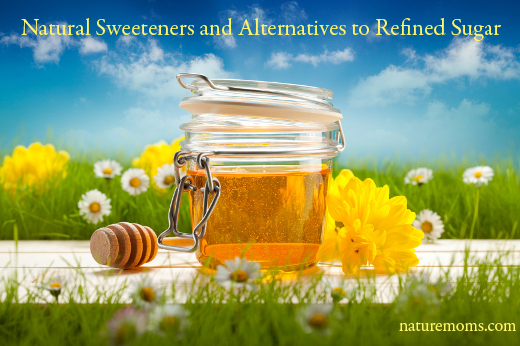Our desire for something sweet to eat is very natural. The desire for something sweet or sugar craving is the body’s signal to you that it needs some energy packed food. Unfortunately with much of the processed sugar we eat, our bodies are not getting any of the substantial nutrients, vitamins or minerals that it expects and needs and that would normally be present in a natural, unprocessed food product.
I also find that when you regularly consume processed, refined sugars you come to accept that sweets taste a certain way and REAL sweeteners start to taste “off” to us. Even delicious fruits like watermelon and mango can’t compete anymore. When I had kids I decided that it was very important to me that their taste buds not get “ruined” like that. Thankfully most times my kids will pick juicy watermelon over a chocolate bar. I even got my mom hooked on Stevia.
Natural sweeteners provide the ideal solution for your taste buds and your nutritional needs. If you are going to have sweets why not make them health building versions right?
Barley Malt Syrup – This syrup is made from sprouted barley and is dark brown and thick with a distinctive flavor like molasses. It is half as sweet as white sugar and is best used in spice cakes, ginger bread and baked beans.
Sucanat – This is a natural sweetener that comes from organically grown sugar cane. It is actually the sugar cane juice that is then evaporated using a special Swiss process. In its natural state it is highly nutritious because the molasses is not removed. For a refreshing drink drop a little Sucanat in water – hot or cold.
Evaporated White Grape Juice and Brown Rice Syrup – This yellowish-white granulated sweetener is good to use when the recipe you’re using requires something lighter colored than Sucanat. If the fruit flavor will be too strong for what you are preparing you can try using half Sucanat/half brown rice syrup. Be aware though that brown rice syrup has come under fire lately for high arsenic levels.
Stevia – This comes from the plant of the same name. It is 300 times sweeter than sugar so it is used in extremely small amounts. A drop or two would be all you need for a cup of coffee. It is also a great option for diabetics and you can buy entire cookbooks that use this sweetener.
Unpasteurized Honey – The plant enzyme amylase is an important nutritional ingredient found in raw honey (not pasteurized). This enzyme is concentrated in the pollen of flowers and is effective in helping the pre-digestion of starchy foods. I use raw honey a lot in my home.
Most honey you can buy in your stores is pasteurized which means it has been heated for up to 24 hours to prevent it from turning hard or hazy. Still even though honey is not as high in vitamins and minerals as Sucanat it is a good natural sweetener. The absolute BEST honey IMO is creamy, rich Tropical Traditions Organic Raw Honey.
Coconut Sugar – We have use coconut sugar quite often. It is harvested from unopened coconut blossoms, then boiled down to a dark brown sap. There are no additives and no stripping of minerals and nutrients. You can buy in a semi liquid sap form and also dried into crystals. I use the dried variety the most as I find it very useful in paleo recipes that have lots of wet ingredients where honey or maple syrup just won’t do.
Pure Maple Syrup – Who could forget maple syrup? It is natural and made from the sap of maple trees. Just make sure to buy the pricier pure brands or you will get some with all kinds of additives.
Frozen Juice Concentrates – Even though frozen fruit juice concentrates in your store have been pasteurized they are far healthier for sweetening a sauce or salad dressing than white sugar. Orange, pineapple and apple concentrates are great for sweetening salad dressings.
Dates and Raisins – Here’s a treat that you’ll likely love as an alternative sweetener. Take a handful of raisins and dates and place them in your blender with a ½ cup of water. Blend for 3 minutes or so and your ingredients will turn into a caramel colored pudding-like substance. The flavor is wonderful and it can be used to top off your fruit salads, or used in baking and creating healthy desserts. I use dates to sweeten green smoothies quite often. I have also pureed them with avocado to make fillings for raw pies.
Stuff to Avoid
White Sugar
Brown Sugar – Brown sugar is usually white sugar with molasses or caramel coloring.
Fructose
D-tagatose
Corn Syrup
Dextrose
Artificial Sweeteners – Nutrasweet, Equal, Spoonful, Neotame, Sunette, Splenda. These have not be proven to be safe – just the opposite in fact so don’t be a guinea pig for chemcial sweetener companies.
MSG – Monosodium Glutamate
Here is to a sweet and healthy life. :)




